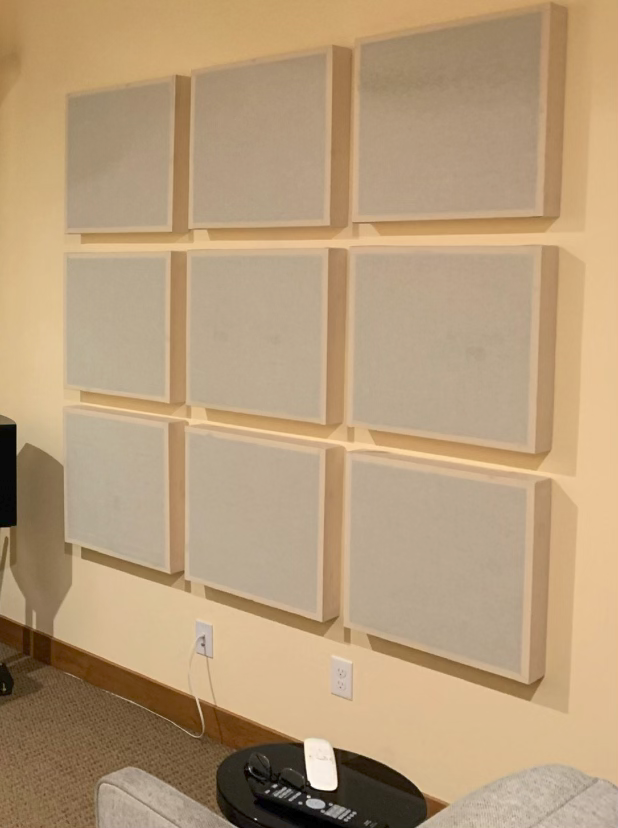I’ve linked to various tutorials about building acoustic (absorption) panels over the years.
I’ve recently learned that these guides are sometimes more cumbersome than helpful. Hopefully this post can be a short and simple summary of a process for building DIY panels. This is based on one set of panels that I made.
I built some wooden frames. I like so called “1x4” pine boards from a big box store for this. (They are actually 3/4” x 3.5” but that’s a whole other topic.) I like to build a frame that is 2’x4’ or 2’x2’ — and that is about 3.5” deep (conveniently the depth you get when using a “1x4” pine board.) Here is a pile of 2’x2’x3.5” frames I made:
I filled the frames with insulation from Home Depot. I used Rockwool Comfortboard which they don’t often carry, but something like this Rockwool should work, as well. (Yes, many guides online prefer Owens Corning 704 sheets or similar materials. The effective difference is miniscule.)
Then I wrapped them in muslin fabric. Any fabric you can blow through should work, but fire rated acoustic fabric may be the best choice.
And then I hung them on the wall with picture hanging hooks:
And that’s it.
Notes:
As you can see, the fabric I chose was too sheer (and allowed the different materials to be visible) so I replaced it with better fabric later.
I used “pocket holes” to construct the frames, but that is not required. Here is a fine video showing another technique from Nick Buol that he shared on AVS Forum:
Finally, we could discuss the impact of different depths, and air gaps, and insulation types, and fabrics, and so on. But it turns out, as long as you make something at least 3.5” deep and you use real insulation (not cheap foam*) you’ll have a 95% solution. So let’s keep this one simple.
Okay, you want to ensure that last 5% is address?
Internal materials: Many types of insulation can work in a DIY panel. This web site (http://www.bobgolds.com/AbsorptionCoefficients.htm) lists the "absorption coefficient" (how well a material absorbs rather than reflects sound) for many common materials. And this one (
http://www.acousticmodelling.com
) gets into even more detail, helping you understand air gaps, using scrims, etc.
Whether you choose something from this list, or something else, I would stick with a material that is formally measured in a lab to have an absorption coefficient of at least 1.0 at 250hz. If you can get that down to 120hz, you are doing GREAT. Chances are good your multi sub setup will solve the issues below that place quite well.
Fabric Covering: Note that if you make your own panels, you should pay attention to the fabric you use to cover them. If you are using the same fabric to cover both panels and speakers you want something that is VERY transparent and neutral. If this is just for panels, you can be a little less stringent.
Grimani has tested and used this fabric with success: MelloTone Speaker Grill Fabric I am particularly fond of that fabric because it is fire rated. Safety is a good thing.
There is a particular black stretch velvet available from Hobby Lobby that measures quite transparent. It is not fire rated, so proceed with caution. The following two graphs are from posts on AVSForum.
Guilford of Main and the fabrics from AcoustiMac (three of which are shown below) are in some cases fine for speaker and panels, but in other cases would ONLY be appropriate on a panel (where complete transparency is less critical):
Footnote:
*To be fair, there are some specialist foams that can work pretty well…..but they cost about twice as much as traditional insulation and are less easy to source……and are sometimes confused with poor performing, highly flammable, cheap foam.








